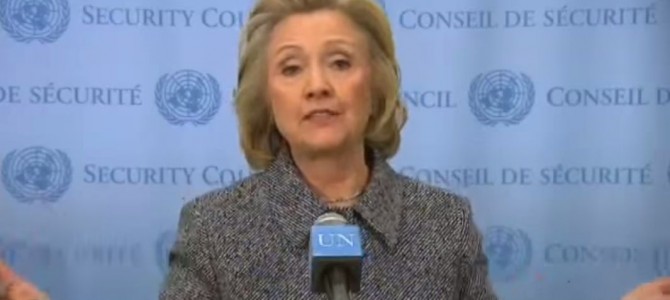During her disastrous press conference yesterday, former Secretary of State Hillary Clinton tried to give the impression that no sensitive or classified information was ever sent or received through her private e-mail account. Here’s the transcript of the question and answer on the topic of classified information:
QUESTION: Were you ever — were you ever specifically briefed on the security implications of using — using your own email server and using your personal address to email with the president?
CLINTON: I did not email any classified material to anyone on my email. There is no classified material.
So I’m certainly well-aware of the classification requirements and did not send classified material.
If you paid even the tiniest amount of attention to how the Clintons handled tough questions about their affairs in the 1990’s, then you’ll know you can drive a truck through the myriad loopholes in this answer from Hillary. I counted at least 6 huge problems with Hillary’s answer that could spell trouble for her going forward.
1) She wasn’t actually asked about classified information
Note that the question she was asked never mentioned classified or sensitive information. Instead, the question appeared to be related to hacking risk. Why a question about hacking? Because the e-mail account of one of Hillary’s longtime confidants, Sid Blumenthal, was hacked by Guccifer, who then released numerous sensitive, work-related e-mails that Blumenthal sent to Hillary.
Hillary ignored the question that was asked and went straight to the two-part talking point answer she wanted to deliver: 1) she did not send classified material, and 2) there is no classified material.
2) Did she receive classified information?
Because Hillary is both a lawyer and a Clinton, we kind of have to assume her answer was intentionally phrased: she “did not send classified material.” Why did she not say that she “did not send or receive classified material”? Is it because she actually did receive classified material?
3) “There is no classified material.”
There’s that word: is. The Clintons have a history with that word:
During a deposition taken as part of a sexual harassment suit, former President Bill Clinton was asked whether he had a sexual relationship with Monica Lewinsky. His answer? “There is no improper relationship.”
Here’s the infamous response he gave (courtesy of footnote 1,128 of the Starr report) when pressed by his interlocutors who knew for a fact that he had had a sexual relationship with Monica Lewinsky:
It depends on what the meaning of the word ‘is’ is. If the — if he — if ‘is’ means is and never has been, that is not — that is one thing. If it means there is none, that was a completely true statement. . . . Now, if someone had asked me on that day, are you having any kind of sexual relations with Ms. Lewinsky, that is, asked me a question in the present tense, I would have said no. And it would have been completely true.
Which brings us back to Hillary’s answer to a question that wasn’t asked: “There is no classified material.”
4) Was there ever classified material?
Again, because a Clinton will always be a Clinton and “is” will always be a present tense reference, we’re now forced to ask if there was ever classified material passed through Hillary’s phone or private e-mail server.
In all probability, the answer is yes:
The State Dept runs a 24/7 ops center which disseminates classified info to leadership via alerts & other communiques.
— Morgen (@morgenr) March 11, 2015
Did Hillary receive these classified alerts? Evidence suggests, yes.
https://t.co/N92Xp24Lyr pic.twitter.com/7PGbV5fdGm
— Morgen (@morgenr) March 11, 2015
Noting again that according to a published account, Hillary received Op Center alerts on her Blackberry. https://t.co/oydRxwTMsl
— Morgen (@morgenr) March 11, 2015
Reason Hillary is emphasizing she didn't deal in classified info is that this would be a bright-line violation of the law.
— Morgen (@morgenr) March 11, 2015
Which brings us to our next problem…
5) If there was classified info, but there is no classified info, did she destroy it all?
You know the old saying that the cover-up is always worse than the crime? That would apply here. If we parse Hillary’s answer and take her at her word, we’re left with the rather disturbing possibility that Hillary received classified information, that she destroyed the evidence of this, and that we currently have no way of knowing the extent to which national security may have been compromised by her desire to run a private, off-books e-mail service.
The Federal Records Act is pretty clear about how federal records are to be maintained. It’s also clear that agency records custodians are supposed to have firm guidelines and policies regarding the retention or destruction of federal records:
Program managers should ensure that requirements for records creation and recordkeeping are included in the design and implementation of electronic systems supporting their programs. Policy, procedures, and controls built into the system should ensure that only authorized users can create records and that no records are altered or deleted except as authorized.
To this day, neither Hillary nor her team has provided any information about their e-mail retention policies and procedures other than “trust us.”
6) You’ll notice Hillary never mentioned sensitive information
Not all closely held information created or distributed by federal officials is necessarily “classified.” The unauthorized disclosure of this information, often referred to as “sensitive” information, could harm U.S. national security even if the information isn’t technically classified. “For Official Use Only,” or FOUO, is a common type of sensitive but unclassified information. “Sensitive but Unclassified,” or SBU, is another. The government has straightforward principles outlining proper ways to handle information that may be sensitive but not classified:
For any document/product correctly bearing the U//FOUO handling instruction, certain safeguards must be taken. Generally speaking, the material should be treated as if it were classified CONFIDENTIAL. This means it cannot be discarded in the open trash, made available to the general public, or posted on an uncontrolled website. It can, however, be shared with individuals with a need to know the content, while still under the control of the individual possessing the document or product. For example, U//FOUO material relating to security precautions during overseas assignments may be shared with family members at home. The material should then be returned to the government office and be properly retained or destroyed. Wherever possible, U//FOUO information should not be passed over unencrypted communications lines (e.g., open phones, non-secure fax, personal e-mails). If no secure communications are available for transmission, U//FOUO material may be sent via unprotected means, with supervisory approval after risk has been assessed.
Did Hillary handle sensitive information? Judging by her answer, I think we can pretty confidently say Hillary both sent and received sensitive information via her private e-mail. What security protocols did she undertake to make sure the information could not be seen by any unauthorized individuals? Who approved that security scheme? What process did she and her team use to ensure that the material was “returned to the government office and…properly retained or destroyed?
The problem with Hillary’s very legalistic answer about her handling of classified information is that it raises far more questions than it answers. Is Hillary’s dream of winning a presidential campaign in danger as a result? It probably depends on what the meaning of “is” is.









